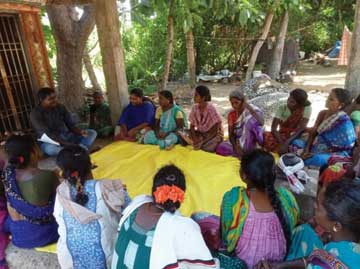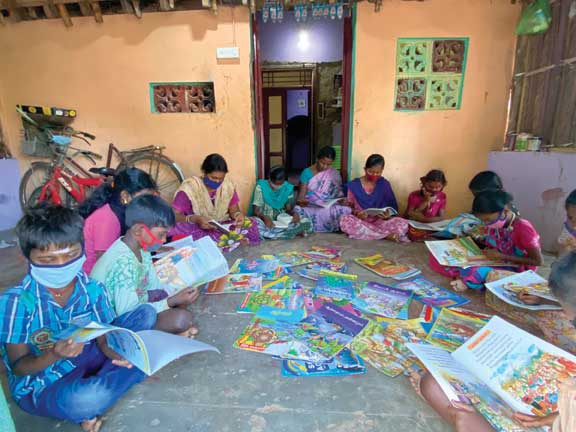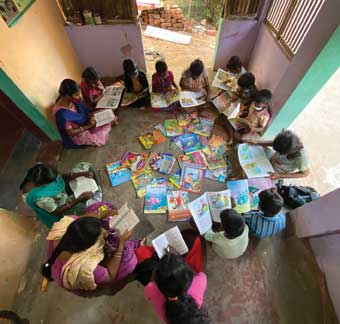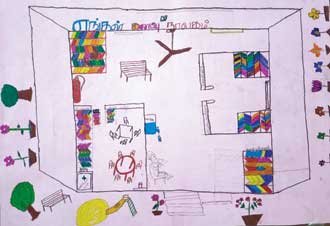R. Devabalan
Libraries are a potential tool to transform individuals, communities, and societies at large. In a country like India, where disparities are always on the rise, with poor funding, inadequate infrastructure and lack of trained personnel, libraries still elude the poor and marginalized, especially girls and women. Having been part of a project, which focuses on increasing rural communities’ access to libraries and promoting a culture of reading among communities, I always wanted to know whether libraries are the real priority of the local community and how and if they can become a primary priority of the local communities.
Every village panchayat in Kattumannarkoil block of Cuddalore district has a library, which is always closed. An interaction with community members, mostly women and children, revealed that there are multiple factors influencing the functioning and access to libraries.

Do you read? I asked at one of the sessions at Koodalaiyathur village. Around 20 women gathered at the meeting smiled at me shyly and looked down at the ground. Boomadevi, a young woman in her early thirties, said, “No, where do we have time to read, and when we have no books, how we will read?” I reminded her about the Panchayat library and she said, “It’s far from our place, we don’t go there.” The distance is not only about location but libraries setup in areas that belong to other castes are not accessible to scheduled caste communities. Even though there is no verbal and written restriction, scheduled caste people avoid using the libraries. Over 80% of the community members have not made even a single visit to the panchayat libraries.
Have you visited the library in your village? Cauvery, a 17-year-old girl responded, “No, because men and young boys only use it.” Gender plays a critical role in enabling girls access to the libraries. As libraries are located away from the village, usually men and young boys control the space. The parents expect girls to support their families by cooking, field work at their farms, and taking care of their siblings. Spending their free hours reading books is not considered a good thing by the parents. Lack of mobility prevents girls from visiting libraries and poor motivation and lack of support from schoolteachers denies them an opportunity to borrow books from the school libraries, and most schoolteachers don’t lend books to school children. When schools cannot motivate the children to read books at a young age, the older children don’t value the importance of reading.

Location of the libraries is a major barrier in increasing community access to libraries. The government must make efforts to set up libraries in places where different communities can access them. In Koodalaiyathur village, the library is in a primary school building where the children get to read the books. Keeping libraries closer to community habitation will lead not only to increased walk-ins but also to making that space safe for girls.
Why don’t communities access libraries? There are four major barriers that make libraries less attractive to the community – functioning hours, poor infrastructure, collection of books and untrained librarians. The functioning hours of libraries in rural areas are not in alignment with the free hours of the rural communities. Most of them work in their fields in the morning and are back home late noon. Even though the official functioning hours of libraries are 8a.m to 1:00p.m and 4p.m-7p.m, they are open for just two hours in a day from 10a.m to 12p.m and sometimes not at all. When the libraries open,the men go to work, women go to the fields, and children go to school. Hence, lack of flexibility in library hours dissuades potential readers. As most of the libraries have no electricity, the libraries cannot function beyond 5p.m.

The libraries are housed in dilapidated buildings, with broken chairs and tables, making readers uncomfortable. The libraries also have no water supply and toilet facilities and power supply too is a major problem. The Panchayat also uses the library space for cooking and sheltering communities affected by floods and rains. Collection of books is a major issue which makes libraries alien to the local population. The book collection is not adequate and appropriate for different age groups in a community. The government doesn’t consult communities before procuring the books. The government does not monitor the registers maintained at the community libraries to know who reads what? The centralization of procurement of books also puts the community at a disadvantage as they have noway of informing the authorities concerned what they want to read. The children are fond of reading fantasy, historical, and mythological books,but no such books are available. Young adults keen on reading novels and short stories don’t find such books. So, the government should attempt to engage with rural communities and find out what they want to read and having those books will motivate rural communities to use the libraries, rather than force people to read books chosen by the government.

An untrained librarian makes the library a dead space. The librarian is provided an honorarium to maintain the library but without basic training in organizing books, or engaging with the community to promote library activities, and not sharing information on new books that have been added affects library functioning. Lack of incentives and irregular payment leads to a continued lockdown of libraries in rural areas. The government should provide for an adequate budget to train and handhold librarians regularly, besides paying their honorarium on time.
When we asked a group of young adolescents in Eachampoondi village to draw their dream library and what it should contain, their art work showed separate reading sections for children and adults, a play area surrounded by trees and a garden, first aid, fire safety and water facilities.
Public libraries can be made more functional if they are used as learning centres for the communities. Market information on commodities, weather reports to help farmers plan their activities, conducting meetings for self-help groups and helping children share their stories with other children can strengthen the public library system.
The author is a development professional at CARE India and is currently promoting community libraries to support young readers in rural areas of Cuddalore district, Tamil Nadu. He can be reached at rdevabalan@careindia.org.
